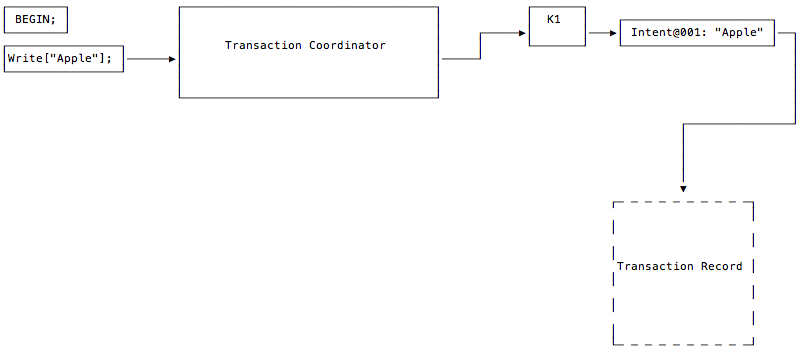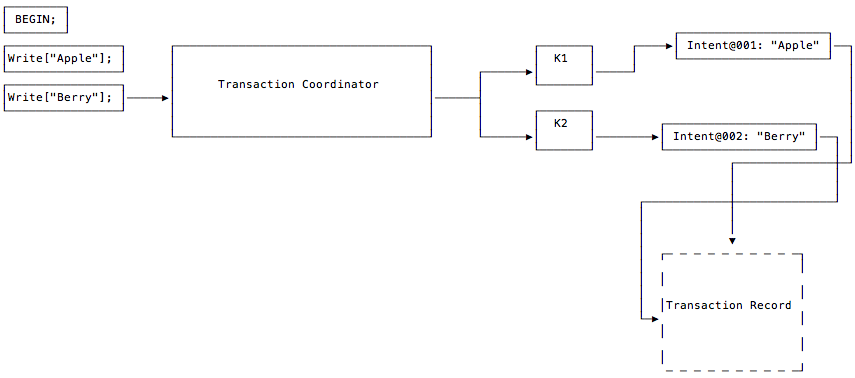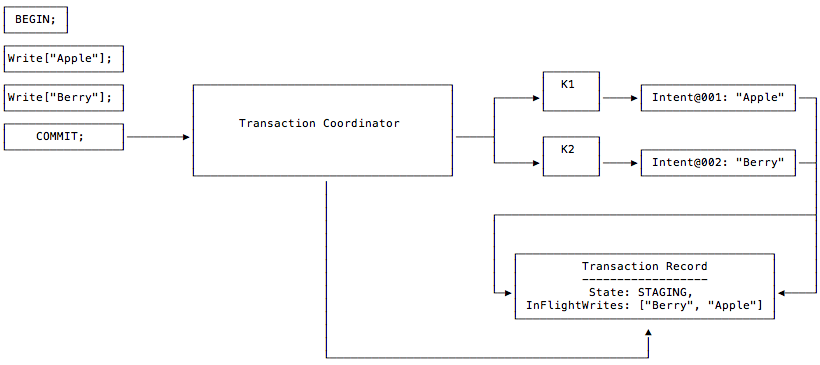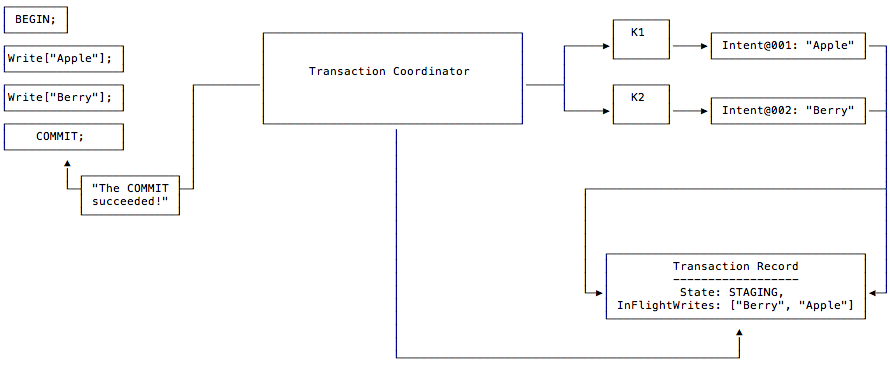
The transaction layer of CockroachDB's architecture implements support for ACID transactions by coordinating concurrent operations.
If you haven't already, we recommend reading the Architecture Overview.
Overview
Above all else, CockroachDB believes consistency is the most important feature of a database––without it, developers cannot build reliable tools, and businesses suffer from potentially subtle and hard to detect anomalies.
To provide consistency, CockroachDB implements full support for ACID transaction semantics in the transaction layer. However, it's important to realize that all statements are handled as transactions, including single statements––this is sometimes referred to as "autocommit mode" because it behaves as if every statement is followed by a COMMIT.
For code samples of using transactions in CockroachDB, see our documentation on transactions.
Because CockroachDB enables transactions that can span your entire cluster (including cross-range and cross-table transactions), it achieves correctness using a distributed, atomic commit protocol called Parallel Commits.
Writes and reads (phase 1)
Writing
When the transaction layer executes write operations, it doesn't directly write values to disk. Instead, it creates two things that help it mediate a distributed transaction:
Write intents for all of a transaction’s writes, which represent a provisional, uncommitted state. These are essentially the same as standard multi-version concurrency control (MVCC) values but also contain a pointer to the transaction record stored on the cluster.
A transaction record stored in the range where the first write occurs, which includes the transaction's current state (which is either
PENDING,STAGING,COMMITTED, orABORTED).
As write intents are created, CockroachDB checks for newer committed values. If newer committed values exist, the transaction may be restarted. If existing write intents for the same keys exist, it is resolved as a transaction conflict.
If transactions fail for other reasons, such as failing to pass a SQL constraint, the transaction is aborted.
Reading
If the transaction has not been aborted, the transaction layer begins executing read operations. If a read only encounters standard MVCC values, everything is fine. However, if it encounters any write intents, the operation must be resolved as a transaction conflict.
Commits (phase 2)
CockroachDB checks the running transaction's record to see if it's been ABORTED; if it has, it restarts the transaction.
In the common case, it sets the transaction record's state to STAGING, and checks the transaction's pending write intents to see if they have succeeded (i.e., been replicated across the cluster).
If the transaction passes these checks, CockroachDB responds with the transaction's success to the client, and moves on to the cleanup phase. At this point, the transaction is committed, and the client is free to begin sending more requests to the cluster.
For a more detailed walkthrough of the commit protocol, see Parallel Commits.
Cleanup (asynchronous phase 3)
After the transaction has been committed, it should be marked as such, and all of the write intents should be resolved. To do this, the coordinating node––which kept a track of all of the keys it wrote––reaches out and:
- Moves the state of the transaction record from
STAGINGtoCOMMITTED. - Resolves the transaction's write intents to MVCC values by removing the element that points it to the transaction record.
- Deletes the write intents.
This is simply an optimization, though. If operations in the future encounter write intents, they always check their transaction records––any operation can resolve or remove write intents by checking the transaction record's status.
Interactions with other layers
In relationship to other layers in CockroachDB, the transaction layer:
- Receives KV operations from the SQL layer.
- Controls the flow of KV operations sent to the distribution layer.
Technical details and components
Time and hybrid logical clocks
In distributed systems, ordering and causality are difficult problems to solve. While it's possible to rely entirely on Raft consensus to maintain serializability, it would be inefficient for reading data. To optimize performance of reads, CockroachDB implements hybrid-logical clocks (HLC) which are composed of a physical component (always close to local wall time) and a logical component (used to distinguish between events with the same physical component). This means that HLC time is always greater than or equal to the wall time. You can find more detail in the HLC paper.
In terms of transactions, the gateway node picks a timestamp for the transaction using HLC time. Whenever a transaction's timestamp is mentioned, it's an HLC value. This timestamp is used to both track versions of values (through multi-version concurrency control), as well as provide our transactional isolation guarantees.
When nodes send requests to other nodes, they include the timestamp generated by their local HLCs (which includes both physical and logical components). When nodes receive requests, they inform their local HLC of the timestamp supplied with the event by the sender. This is useful in guaranteeing that all data read/written on a node is at a timestamp less than the next HLC time.
This then lets the node primarily responsible for the range (i.e., the leaseholder) serve reads for data it stores by ensuring the transaction reading the data is at an HLC time greater than the MVCC value it's reading (i.e., the read always happens "after" the write).
Max clock offset enforcement
CockroachDB requires moderate levels of clock synchronization to preserve data consistency. For this reason, when a node detects that its clock is out of sync with at least half of the other nodes in the cluster by 80% of the maximum offset allowed (500ms by default), it crashes immediately.
While serializable consistency is maintained regardless of clock skew, skew outside the configured clock offset bounds can result in violations of single-key linearizability between causally dependent transactions. It's therefore important to prevent clocks from drifting too far by running NTP or other clock synchronization software on each node.
For more detail about the risks that large clock offsets can cause, see What happens when node clocks are not properly synchronized?
Timestamp cache
As part of providing serializability, whenever an operation reads a value, we store the operation's timestamp in a timestamp cache, which shows the high-water mark for values being read.
Whenever a write occurs, its timestamp is checked against the timestamp cache. If the timestamp is less than the timestamp cache's latest value, we attempt to push the timestamp for its transaction forward to a later time. Pushing the timestamp might cause the transaction to restart in the second phase of the transaction (see read refreshing).
client.Txn and TxnCoordSender
As we mentioned in the SQL layer's architectural overview, CockroachDB converts all SQL statements into key-value (KV) operations, which is how data is ultimately stored and accessed.
All of the KV operations generated from the SQL layer use client.Txn, which is the transactional interface for the CockroachDB KV layer––but, as we discussed above, all statements are treated as transactions, so all statements use this interface.
However, client.Txn is actually just a wrapper around TxnCoordSender, which plays a crucial role in our code base by:
- Dealing with transactions' state. After a transaction is started,
TxnCoordSenderstarts asynchronously sending heartbeat messages to that transaction's transaction record, which signals that it should be kept alive. If theTxnCoordSender's heartbeating stops, the transaction record is moved to theABORTEDstatus. - Tracking each written key or key range over the course of the transaction.
- Clearing the accumulated write intent for the transaction when it's committed or aborted. All requests being performed as part of a transaction have to go through the same
TxnCoordSenderto account for all of its write intents, which optimizes the cleanup process.
After setting up this bookkeeping, the request is passed to the DistSender in the distribution layer.
Latch manager
As write operations occur for a range, the range's leaseholder serializes them; that is to say that they are placed into some consistent order.
To enforce this serialization, the leaseholder creates a "latch" for the keys in the write value, providing uncontested access to the keys. If other operations come into the leaseholder for the same set of keys, they must wait for the latch to be released before they can proceed.
Of note, only write operations generate a latch for the keys. Read operations do not block other operations from executing.
Another way to think of a latch is like a mutex, which is only needed for the duration of a low-level operation. To coordinate longer-running, higher-level operations (i.e., client transactions), we use a durable system of write intents.
Transaction records
To track the status of a transaction's execution, we write a value called a transaction record to our key-value store. All of a transaction's write intents point back to this record, which lets any transaction check the status of any write intents it encounters. This kind of canonical record is crucial for supporting concurrency in a distributed environment.
Transaction records are always written to the same range as the first key in the transaction, which is known by the TxnCoordSender. However, the transaction record itself isn't created until one of the following conditions occur:
- The write operation commits
- The
TxnCoordSenderheartbeats the transaction - An operation forces the transaction to abort
Given this mechanism, the transaction record uses the following states:
PENDING: Indicates that the write intent's transaction is still in progress.COMMITTED: Once a transaction has completed, this status indicates that write intents can be treated as committed values.STAGING: Used to enable the Parallel Commits feature. Depending on the state of the write intents referenced by this record, the transaction may or may not be in a committed state.ABORTED: Indicates that the transaction was aborted and its values should be discarded.- Record does not exist: If a transaction encounters a write intent whose transaction record doesn't exist, it uses the write intent's timestamp to determine how to proceed. If the write intent's timestamp is within the transaction liveness threshold, the write intent's transaction is treated as if it is
PENDING, otherwise it's treated as if the transaction isABORTED.
The transaction record for a committed transaction remains until all its write intents are converted to MVCC values.
Write intents
Values in CockroachDB are not written directly to the storage layer; instead everything is written in a provisional state known as a "write intent." These are essentially MVCC records with an additional value added to them which identifies the transaction record to which the value belongs.
Whenever an operation encounters a write intent (instead of an MVCC value), it looks up the status of the transaction record to understand how it should treat the write intent value. If the transaction record is missing, the operation checks the write intent's timestamp and evaluates whether or not it is considered expired.
Resolving write intents
Whenever an operation encounters a write intent for a key, it attempts to "resolve" it, the result of which depends on the write intent's transaction record:
COMMITTED: The operation reads the write intent and converts it to an MVCC value by removing the write intent's pointer to the transaction record.ABORTED: The write intent is ignored and deleted.PENDING: This signals there is a transaction conflict, which must be resolved.STAGING: This signals that the operation should check whether the staging transaction is still in progress by verifying that the transaction coordinator is still heartbeating the staging transaction’s record. If the coordinator is still heartbeating the record, the operation should wait. For more information, see Parallel Commits.- Record does not exist: If the write intent was created within the transaction liveness threshold, it's the same as
PENDING, otherwise it's treated asABORTED.
Isolation levels
Isolation is an element of ACID transactions, which determines how concurrency is controlled, and ultimately guarantees consistency.
CockroachDB executes all transactions at the strongest ANSI transaction isolation level: SERIALIZABLE. All other ANSI transaction isolation levels (e.g., SNAPSHOT, READ UNCOMMITTED, READ COMMITTED, and REPEATABLE READ) are automatically upgraded to SERIALIZABLE. Weaker isolation levels have historically been used to maximize transaction throughput. However, recent research has demonstrated that the use of weak isolation levels results in substantial vulnerability to concurrency-based attacks.
CockroachDB now only supports SERIALIZABLE isolation. In previous versions of CockroachDB, you could set transactions to SNAPSHOT isolation, but that feature has been removed.
SERIALIZABLE isolation does not allow any anomalies in your data, and is enforced by requiring the client to retry transactions if serializability violations are possible.
Transaction conflicts
CockroachDB's transactions allow the following types of conflicts that involve running into an intent:
- Write/write, where two
PENDINGtransactions create write intents for the same key. - Write/read, when a read encounters an existing write intent with a timestamp less than its own.
To make this simpler to understand, we'll call the first transaction TxnA and the transaction that encounters its write intents TxnB.
CockroachDB proceeds through the following steps:
If the transaction has an explicit priority set (i.e.,
HIGHorLOW), the transaction with the lower priority is aborted (in the write/write case) or has its timestamp pushed (in the write/read case).If the encountered transaction is expired, it's
ABORTEDand conflict resolution succeeds. We consider a write intent expired if:- It doesn't have a transaction record and its timestamp is outside of the transaction liveness threshold.
- Its transaction record hasn't been heartbeated within the transaction liveness threshold.
TxnBenters theTxnWaitQueueto wait forTxnAto complete.
Additionally, the following types of conflicts that do not involve running into intents can arise:
- Write after read, when a write with a lower timestamp encounters a later read. This is handled through the timestamp cache.
- Read within uncertainty window, when a read encounters a value with a higher timestamp but it's ambiguous whether the value should be considered to be in the future or in the past of the transaction because of possible clock skew. This is handled by attempting to push the transaction's timestamp beyond the uncertain value (see read refreshing). Note that, if the transaction has to be retried, reads will never encounter uncertainty issues on any node which was previously visited, and that there's never any uncertainty on values read from the transaction's gateway node.
TxnWaitQueue
The TxnWaitQueue tracks all transactions that could not push a transaction whose writes they encountered, and must wait for the blocking transaction to complete before they can proceed.
The TxnWaitQueue's structure is a map of blocking transaction IDs to those they're blocking. For example:
txnA -> txn1, txn2
txnB -> txn3, txn4, txn5
Importantly, all of this activity happens on a single node, which is the leader of the range's Raft group that contains the transaction record.
Once the transaction does resolve––by committing or aborting––a signal is sent to the TxnWaitQueue, which lets all transactions that were blocked by the resolved transaction begin executing.
Blocked transactions also check the status of their own transaction to ensure they're still active. If the blocked transaction was aborted, it's simply removed.
If there is a deadlock between transactions (i.e., they're each blocked by each other's Write Intents), one of the transactions is randomly aborted. In the above example, this would happen if TxnA blocked TxnB on key1 and TxnB blocked TxnA on key2.
Read refreshing
Whenever a transaction's timestamp has been pushed, additional checks are required before allowing it to commit at the pushed timestamp: any values which the transaction previously read must be checked to verify that no writes have subsequently occurred between the original transaction timestamp and the pushed transaction timestamp. This check prevents serializability violation. The check is done by keeping track of all the reads using a dedicated RefreshRequest. If this succeeds, the transaction is allowed to commit (transactions perform this check at commit time if they've been pushed by a different transaction or by the timestamp cache, or they perform the check whenever they encounter a ReadWithinUncertaintyIntervalError immediately, before continuing).
If the refreshing is unsuccessful, then the transaction must be retried at the pushed timestamp.
Transaction pipelining
Transactional writes are pipelined when being replicated and when being written to disk, dramatically reducing the latency of transactions that perform multiple writes. For example, consider the following transaction:
-- CREATE TABLE kv (id UUID PRIMARY KEY DEFAULT gen_random_uuid(), key VARCHAR, value VARCHAR);
> BEGIN;
INSERT into kv (key, value) VALUES ('apple', 'red');
INSERT into kv (key, value) VALUES ('banana', 'yellow');
INSERT into kv (key, value) VALUES ('orange', 'orange');
COMMIT;
With transaction pipelining, write intents are replicated from leaseholders in parallel, so the waiting all happens at the end, at transaction commit time.
At a high level, transaction pipelining works as follows:
For each statement, the transaction gateway node communicates with the leaseholders (L1, L2, L3, ..., Li) for the ranges it wants to write to. Since the primary keys in the table above are UUIDs, the ranges are probably split across multiple leaseholders (this is a good thing, as it decreases transaction conflicts).
Each leaseholder Li receives the communication from the transaction gateway node and does the following in parallel:
- Creates write intents and sends them to its follower nodes.
- Responds to the transaction gateway node that the write intents have been sent. Note that replication of the intents is still in-flight at this stage.
When attempting to commit, the transaction gateway node then waits for the write intents to be replicated in parallel to all of the leaseholders' followers. When it receives responses from the leaseholders that the write intents have propagated, it commits the transaction.
In terms of the SQL snippet shown above, all of the waiting for write intents to propagate and be committed happens once, at the very end of the transaction, rather than for each individual write. This means that the cost of multiple writes is not O(n) in the number of SQL DML statements; instead, it's O(1).
Parallel Commits
New in v19.2: The Parallel Commits feature introduces a new, optimized atomic commit protocol that cuts the commit latency of a transaction in half, from two rounds of consensus down to one. Combined with Transaction pipelining, this brings the latency incurred by common OLTP transactions to near the theoretical minimum: the sum of all read latencies plus one round of consensus latency.
Under the new atomic commit protocol, the transaction coordinator can return to the client eagerly when it knows that the writes in the transaction have succeeded. Once this occurs, the transaction coordinator can set the transaction record's state to COMMITTED and resolve the transaction's write intents asynchronously.
The transaction coordinator is able to do this while maintaining correctness guarantees because it populates the transaction record with enough information (via a new STAGING state, and an array of in-flight writes) for other transactions to determine whether all writes in the transaction are present, and thus prove whether or not the transaction is committed.
For an example showing how the Parallel Commits feature works in more detail, see Parallel Commits - step by step.
The latency until intents are resolved is unchanged by the introduction of Parallel Commits: two rounds of consensus are still required to resolve intents. This means that contended workloads are expected to profit less from this feature.
Parallel Commits - step by step
This section contains a step by step example of a transaction that writes its data using the Parallel Commits atomic commit protocol and does not encounter any errors or conflicts.
Step 1
The client starts the transaction. A transaction coordinator is created to manage the state of that transaction.

Step 2
The client issues a write to the "Apple" key. The transaction coordinator begins the process of laying down a write intent on the key where the data will be written. The write intent has a timestamp and a pointer to an as-yet nonexistent transaction record. Additionally, each write intent in the transaction is assigned a unique sequence number which is used to uniquely identify it.
The coordinator avoids creating the record for as long as possible in the transaction's lifecycle as an optimization. The fact that the transaction record does not yet exist is denoted in the diagram by its dotted lines.
The coordinator does not need to wait for write intents to replicate from leaseholders before moving on to the next statement from the client, since that is handled in parallel by Transaction Pipelining.

Step 3
The client issues a write to the "Berry" key. The transaction coordinator lays down a write intent on the key where the data will be written. This write intent has a pointer to the same transaction record as the intent created in Step 2, since these write intents are part of the same transaction.
As before, the coordinator does not need to wait for write intents to replicate from leaseholders before moving on to the next statement from the client.

Step 4
The client issues a request to commit the transaction's writes. The transaction coordinator creates the transaction record and immediately sets the record's state to STAGING, and records the keys of each write that the transaction has in flight.
It does this without waiting to see whether the writes from Steps 2 and 3 have succeeded.

Step 5
The transaction coordinator, having received the client's COMMIT request, waits for the pending writes to succeed (i.e., be replicated across the cluster). Once all of the pending writes have succeeded, the coordinator returns a message to the client, letting it know that its transaction has committed successfully.

The transaction is now considered atomically committed, even though the state of its transaction record is still STAGING. The reason this is still considered an atomic commit condition is that a transaction is considered committed if it is one of the following logically equivalent states:
The transaction record's state is
STAGING, and its list of pending writes have all succeeded (i.e., theInFlightWriteshave achieved consensus across the cluster). Any observer of this transaction can verify that its writes have replicated. Transactions in this state are implicitly committed.The transaction record's state is
COMMITTED. Transactions in this state are explicitly committed.
Despite their logical equivalence, the transaction coordinator now works as quickly as possible to move the transaction record from the STAGING to the COMMITTED state so that other transactions do not encounter a possibly conflicting transaction in the STAGING state and then have to do the work of verifying that the staging transaction's list of pending writes has succeeded. Doing that verification (also known as the "transaction status recovery process") would be slow.
Additionally, when other transactions encounter a transaction in STAGING state, they check whether the staging transaction is still in progress by verifying that the transaction coordinator is still heartbeating that staging transaction’s record. If the coordinator is still heartbeating the record, the other transactions will wait, on the theory that letting the coordinator update the transaction record with the final result of the attempt to commit will be faster than going through the transaction status recovery process. This means that in practice, the transaction status recovery process is only used if the transaction coordinator dies due to an untimely crash.
Technical interactions with other layers
Transaction and SQL layer
The transaction layer receives KV operations from planNodes executed in the SQL layer.
Transaction and distribution layer
The TxnCoordSender sends its KV requests to DistSender in the distribution layer.
What's next?
Learn how CockroachDB presents a unified view of your cluster's data in the distribution layer.